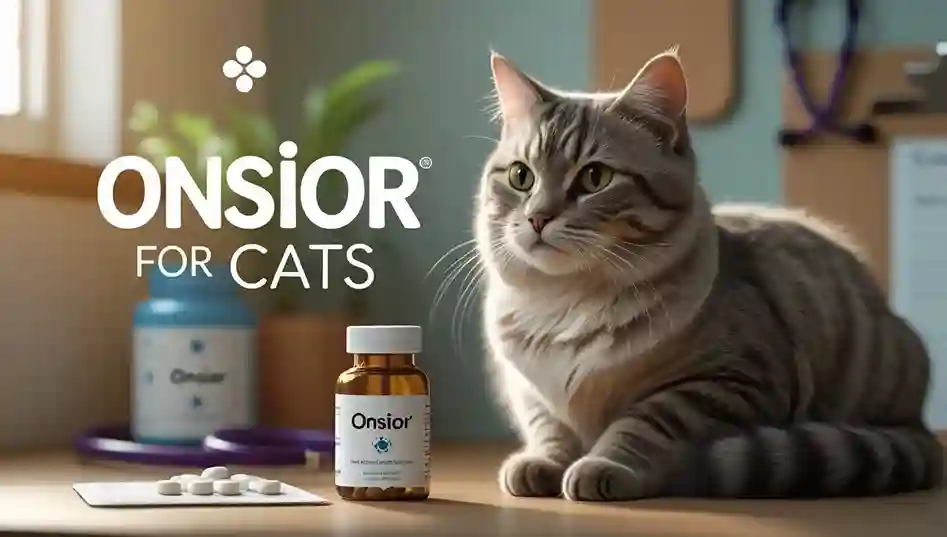As a cat owner, ensuring your feline companion’s health is a top priority. When faced with conditions like high blood pressure, congestive heart failure, or chronic kidney disease, your veterinarian may prescribe Benazepril for Cats, a medication known for its effectiveness in managing these serious health issues.
This guide dives deep into what Benazepril is, how it works, its benefits, potential side effects, and essential considerations for safe use. Whether you’re new to this medication or seeking detailed insights, this article provides comprehensive information to help you make informed decisions for your cat’s well-being.
What is Benazepril for Cats?
Benazepril for Cats is a prescription medication belonging to the class of angiotensin-converting enzyme (ACE) inhibitors. It is primarily used to treat conditions such as congestive heart failure, high blood pressure (hypertension), and chronic kidney disease in cats. By blocking the production of angiotensin II, a hormone that constricts blood vessels, Benazepril helps dilate blood vessels, reducing blood pressure and easing the workload on the heart and kidneys. This makes it a critical tool in managing life-threatening conditions in felines.
How Benazepril Works
Benazepril targets the renin-angiotensin-aldosterone system (RAAS), which regulates blood pressure and fluid balance in the body. When this system is overactive, it can lead to high blood pressure or strain on the heart. Benazepril for Cats lowers blood pressure by relaxing blood vessels, improving blood flow, and reducing fluid retention. For cats with kidney disease, it also decreases pressure in the kidneys’ glomeruli, helping to minimize protein loss in urine (proteinuria).
Common Uses of Benazepril in Cats
Veterinarians prescribe Benazepril for Cats for several conditions, including:
- Congestive Heart Failure: Eases the heart’s workload by lowering blood pressure, allowing it to pump blood more efficiently.
- Hypertension: Manages high blood pressure, which is common in older cats or those with underlying conditions like kidney disease or hyperthyroidism.
- Chronic Kidney Disease: Reduces protein loss in urine and slows the progression of kidney damage.
- Proteinuria: Helps manage excessive protein in the urine, a sign of kidney dysfunction.
Benefits of Benazepril for Cats
Using Benazepril for Cats offers several benefits, particularly for cats with chronic conditions. These include:
- Improved Heart Function: By reducing the strain on the heart, Benazepril can extend the quality and length of life for cats with heart failure.
- Kidney Protection: Lowers blood pressure in the kidneys, slowing the progression of chronic kidney disease and reducing proteinuria.
- Blood Pressure Control: Effectively manages hypertension, preventing complications like organ damage.
- Combination Therapy: Often used alongside other medications like diuretics or pimobendan for a comprehensive treatment plan.
Supporting Your Cat’s Health with Benazepril
For cat owners, Benazepril for Cats can be a game-changer in managing serious health conditions. When used correctly under veterinary supervision, it can significantly improve your cat’s quality of life. For example, a cat with congestive heart failure may experience less fatigue and better breathing, while one with kidney disease may have a slower disease progression, allowing for more time with their loving family.
Dosage and Administration
The standard dosage of Benazepril for Cats is 0.25–0.5 mg/kg of body weight, administered orally every 12–24 hours, as determined by your veterinarian. The exact dosage depends on your cat’s condition, weight, and overall health. Here’s what you need to know about administering Benazepril:
Dosage Guidelines
- Frequency: Typically given once or twice daily, depending on the condition being treated.
- Form: Available as tablets or compounded formulations (e.g., flavored liquids) for cats that resist pills.
- With or Without Food: Can be given with or without a meal, though giving it with food may reduce digestive upset.
- Veterinary Guidance: Never adjust the dosage or stop the medication without consulting your veterinarian, as this could worsen your cat’s condition.
Tips for Administering Benazepril
Administering medication to cats can be challenging. Here are some tips to make the process smoother:
- Use a Pill Popper: A pill popper, like the Pet Piller for Cats available on Amazon, can help deliver tablets directly to the back of your cat’s throat.
- Hide in Treats: Conceal the pill in a treat, such as Greenies Pill Pockets, also available on Amazon, to make it more palatable.
- Compounded Formulations: If your cat refuses tablets, ask your veterinarian about compounded liquids with flavors like chicken or fish.
Always follow your veterinarian’s instructions and monitor your cat for any changes in behavior or health after starting Benazepril for Cats.
Potential Side Effects
While Benazepril for Cats is generally safe, it can cause side effects in some cases. Common side effects include:
- Vomiting
- Diarrhea
- Lethargy
- Loss of appetite
- Low blood pressure (hypotension)
Rare but Serious Side Effects
In rare cases, Benazepril for Cats may cause more severe reactions, such as:
- Kidney dysfunction
- Allergic reactions (e.g., swelling, difficulty breathing)
- Electrolyte imbalances
If you notice any unusual symptoms, contact your veterinarian immediately. Regular monitoring, including blood tests, can help detect potential issues early.
Read More: Strabismus in Cats: Causes & Care Guide
Interactions with Other Medications
Benazepril for Cats may interact with certain medications, including:
- Diuretics (e.g., furosemide)
- Non-steroidal anti-inflammatory drugs (NSAIDs)
- Potassium supplements
Always inform your veterinarian about any medications, supplements, or vitamins your cat is taking to avoid harmful interactions.
Safety Considerations
Before starting Benazepril for Cats, discuss your cat’s full medical history with your veterinarian. Key considerations include:
- Pre-existing Conditions: Cats with severe kidney or liver disease may require adjusted doses or alternative treatments.
- Pregnancy and Nursing: Benazepril is not recommended for pregnant or nursing cats due to potential risks to kittens.
- Off-Label Use: While Benazepril is FDA-approved for humans (brand name: Lotensin), its use in cats is off-label, meaning it’s prescribed based on veterinary discretion.
Monitoring Your Cat
Regular veterinary check-ups are essential when using Benazepril for Cats. Your veterinarian may recommend:
- Blood pressure checks to ensure the medication is effectively managing hypertension.
- Kidney function tests to monitor for any adverse effects.
- Electrolyte panels to detect imbalances.
Amazon Products to Support Benazepril Treatment
To complement Benazepril for Cats, consider these Amazon products to support your cat’s health:
- Pet Piller for Cats: Simplifies administering tablets, reducing stress for both you and your cat. Available for around $5–$10.
- Greenies Pill Pockets: Soft treats that hide pills, making medication time easier. Priced at approximately $8–$12 for a pack.
- Vetoquinol Renal K+ Gel: A potassium supplement to support cats with kidney disease, often used alongside Benazepril. Costs around $15–$20.
- Home Blood Pressure Monitor for Pets: Allows you to track your cat’s blood pressure at home, ensuring Benazepril for Cats is working effectively. Priced at $50–$100.
Always consult your veterinarian before introducing new products or supplements to your cat’s routine.
FAQs About Benazepril for Cats
Based on common questions from pet owners, here are answers to frequently asked questions about Benazepril for Cats:
What is Benazepril used for in cats?
Benazepril is used to treat congestive heart failure, high blood pressure, chronic kidney disease, and proteinuria in cats. It lowers blood pressure and reduces strain on the heart and kidneys.
Is Benazepril safe for cats?
Yes, Benazepril for Cats is generally safe when prescribed by a veterinarian. However, it may cause side effects like vomiting or lethargy, and regular monitoring is recommended.
How much Benazepril should I give my cat?
The typical dose is 0.25–0.5 mg/kg every 12–24 hours, but your veterinarian will determine the exact dosage based on your cat’s condition and weight.
Can Benazepril be given with other medications?
Benazepril can be used with other medications like diuretics or pimobendan, but you should inform your veterinarian about all medications your cat is taking to avoid interactions.
How long does it take for Benazepril to work in cats?
Improvements in symptoms like reduced breathing difficulties or better energy levels may be seen within days to weeks, but full effects may take longer, especially for kidney disease.
Can I stop giving Benazepril to my cat?
Never stop or adjust Benazepril for Cats without consulting your veterinarian, as this could worsen your cat’s condition or lead to complications.
Conclusion
Benazepril for Cats is a powerful medication for managing serious conditions like congestive heart failure, hypertension, and chronic kidney disease. By understanding its uses, dosage, side effects, and safety considerations, you can work with your veterinarian to ensure your cat receives the best care possible.
Pairing Benazepril with supportive products like pill poppers or supplements can further enhance your cat’s treatment plan. Always consult your veterinarian before making changes to your cat’s medication or health routine, and schedule regular check-ups to monitor progress.
Have you used Benazepril for Cats for your feline friend? Share your experience in the comments below or ask any questions you have about this medication.
Sources



